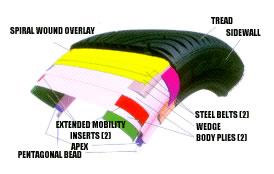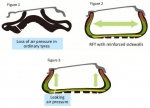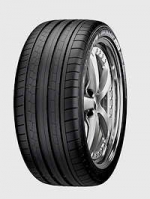28 August 2010 - Over 70% of all drivers have had a flat tyre at one point or another. Over 25% of them felt incapable of changing the tyre themselves, and it’s safe to say that the others didn’t enjoy it much either. Moreover, sudden air loss during a blowout can be one of the most dangerous situations a driver can face.
Now, imagine a tyre that is highly resistant to fatigue and almost all forms of punctures. A tyre that you can keep driving in the event of air loss pressure; a tyre that can carry you home or to a service station safely at any time.That is what Run Flat Tyre promises.
In recent years, run-flat tyres (RFT) have been gaining in popularity, but not yet in Malaysia.In fact, the development of RFT has been around the world for some time. Nowadays, brands such as Michelin, Continental, Goodyear, Bridgestone, Dunlop, Firestone, Pirelli, Yokohama, Goodyear has a range of products, otherwise indicated as the RFT (Run Flat Tyre), SSR (Self Supporting Run-flat) or ZP (Zero Pressure), and so forth.
RFT heralds a new era of safer roads. No longer will drivers have to worry about being stranded or late because of a puncture or even worse, having to deal with a potentially life threatening blowout. Changing tyres on the hard shoulder or in other dangerous situations will also be a thing of the past, as will waiting endlessly for the rescue service.
Construction and Principle:
The main ingredient of tyre is rubber, but rubber itself is unable to cope with any load, thus the load of tyres mainly depend on layers of a reinforced fibre and steel wire. Rubber elasticity is much lower than fibre and steel wire, thus adequate tyre pressure ensures the process of deformation of rubber tyres will be minimal. However, if the tyre is travelling at low tyre pressure condition, the rubber will be deformed, stretching more than the strength of the fibres and elasticity limit of the steel wire. This could cause significant damage to the tyre, as the pressure will eventually destroy the interface between the different raw materials, and in more serious cases, result in tyre failure as shown as above.
The Advantage with Run flat tyres is that they can operate without air in them, for a relatively short distance and low speeds, as their basic shape is kept by rigid components. This rigidity helps a driver maintain control of the vehicle if the tyre loses pressure (Figure 2), and allows the driver to continue driving, the pressurised air contained within the tyre supports the weight of the car. (Figure 3) However, recently tyres have been developed which are able to support the weight of the car by themselves, for a short period of time. New cars are also equipped with tyre pressure monitoring devices which warn the driver of a tyre pressure loss.
Benefits:
* Eliminate the need to change a tyre in bad weather or in dangerous roadside areas.
* Safety and reduced risk of accident – blowouts and tyre deflation can be serious driving risks for drivers.
* Tyres can be driven on for 80 kilometres or more with no air in them enable drivers to get to a mechanic without having to change the tyre after a puncture.
* Car need not be equipped with a spare tyre, resulting in more trunk space.
* The absence of a spare wheel contributes to lower vehicle weight which will in turn reduce fuel consumption, reduce harmful exhaust emissions, improve performance, handling and braking characteristics.
* Tyre pressure monitoring devices warn the driver of a tyre pressure loss.
Disadvantages:
* RFT’s sidewall is harder than ordinary tyres, so comfort is compromised.
* To improve this problem, Bridgestone introduced a new RFT tyre with sidewall texture similar to ordinary tyres, thereby enhancing the comfort of the tyre.
* High replacement costs; and limited replacement choices.
* If the material that penetrated the RFT tyres is not removed, continuous driving will result in the hole getting deeper. Once the hole reaches a depth of more than 5mm, there is no way to remedy them.
While the RFT is not so popular in Malaysia, increased advances in technology and maintenance of tyres translate to lower prices for them. Do not be surprised by the eventual rise in popularity of RFT that could one day put the history of roadside punctures to bed.
Run Flat Tyre abbreviations:
RFT: Run flat tyre
ZP: Zero pressure
EMT: Extended mobility technology
ROF: Run on flat
DSST: Dunlop self supporting technology
SSR: Self supporting runflat
Source: Typrepac.com.my




